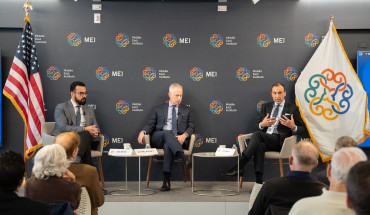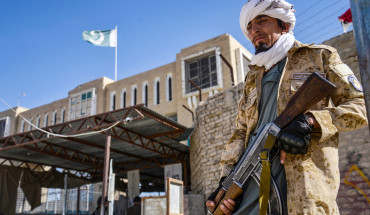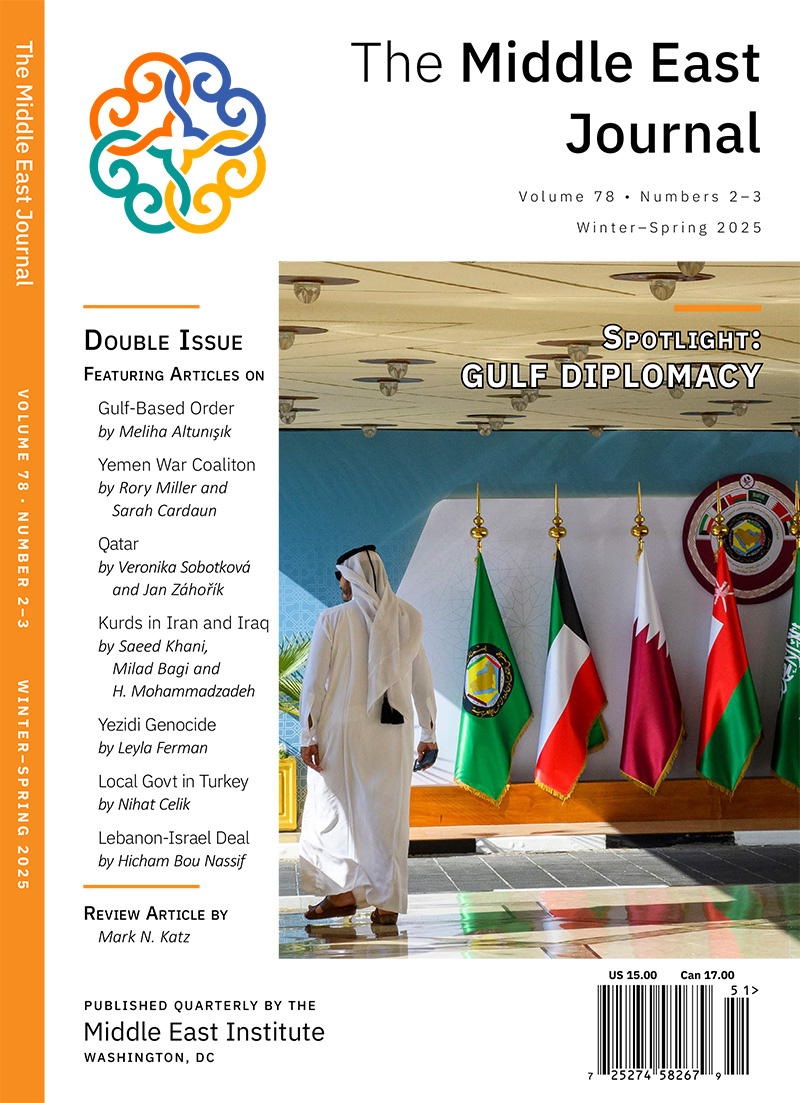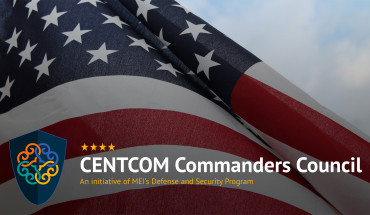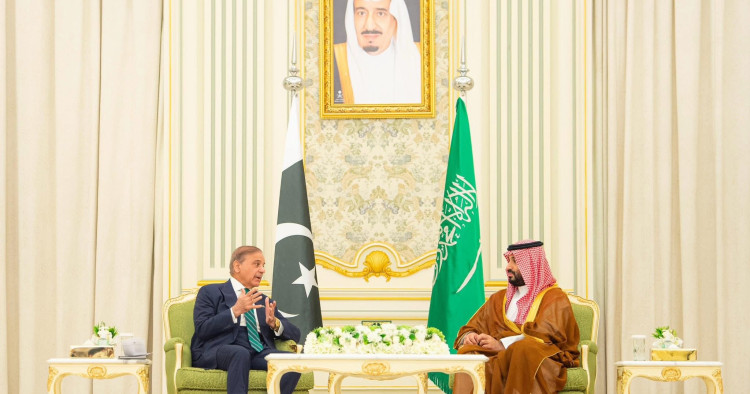The Saudi-Pakistan Strategic Mutual Defense Agreement, signed on September 17, 2025, is a significant regional development. MEI has published several articles that provide different perspectives on the defense pact. For other analysis, please see F. Gregory Gause’s “Don't believe the hype: The modest reality of the Saudi-Pakistani defense pact” and John Calabrese’s “Silent leverage, quiet gains? China and the Saudi-Pakistan defense pact.”
Following Israel’s September 9 strike on Hamas targets in Qatar, Pakistan has taken swift and significant foreign policy steps in response and adopted an unusually assertive stance. This shift was largely influenced by Pakistan’s military chief, Field Marshal Asim Munir. The latter is determined to enhance his country’s strategic autonomy and diplomatic leverage in an increasingly complex international environment by positioning Pakistan as a key security actor and an emerging middle power on the global stage.
Pakistan’s assertive shift in foreign policy
Within days of the Israeli strike, Prime Minister Shehbaz Sharif visited Doha in a show of solidarity. Islamabad also called for an emergency session of the United Nations Security Council and attended an Arab-Islamic summit in the Qatari capital to condemn Israel’s military campaign. Seizing the crisis as an opportunity to elevate Pakistan’s strategic presence in the Gulf and the wider Middle East, its government voiced support for the proposed formation of a joint Arab-Islamic security force, one that would highlight Pakistan’s military capabilities and nuclear deterrence. The meetings of Prime Minister Sharif and Field Marshal Munir with national leaders and defense officials from Islamic countries on the sidelines of the Doha summit brought a dynamic shift in thinking toward the creation of a new regional cooperative security framework. Although the summit participants stopped short of calling for concrete military or economic measures against Israel, the regional gathering laid the groundwork for such policies. Reflective of these developments, Pakistan and Saudi Arabia transformed what had been decades of symbolic gestures of solidarity between them into institutionalized bilateral security commitments by signing an unprecedented Strategic Mutual Defense Agreement (SMDA).
Key features of the Saudi-Pakistani defense pact: Deterrence and collective defense
The Saudi-Pakistani pact establishes a binding framework for joint military engagement in both wartime and peacetime. Joint statements outlining the objectives of the agreement underscore a crucial wartime clause: any act of aggression against one will be treated as an act of aggression against both. In peacetime, the pact’s primary aim is to strengthen defense cooperation and reinforce joint deterrence against any potential threats.
The signed agreement includes two key terms that warrant clarification: what is meant by “joint deterrence” and how “any aggression” is defined, including by whom it might be carried out. First and foremost, the document seems to unequivocally bind the security destinies of Pakistan and Saudi Arabia, formally committing them to defend one another. In the event of war, each country is now obligated to militarily intervene in support of its partner. The emphasis on strengthening joint deterrence in turn makes it clear that the alliance is defensive in nature. While it may extend to preemptive self-defense in response to credible and imminent threats, it does not entail taking offensive action. In essence, neither Pakistan nor Saudi Arabia is expected to use its military forces together with the other to launch an offensive attack on any state unless that state poses an immediate danger to either party or to both. Additionally, the reference to “any aggression” serves to harmonize Islamabad’s and Riyadh’s individual threat perceptions into a unified and collective framework. While Pakistan’s Foreign Office has clarified that the pact is not aimed at any specific country, the broad language suggests it could be applied to any state that commits aggression against either Saudi Arabia or Pakistan.
Strategic timing and regional context
The importance of this defense pact stems both from its timing, coinciding with parallel developments in the Gulf, and from the mutual benefits it offers to Pakistan and Saudi Arabia. First, the pact comes at a moment when the Gulf Cooperation Council (GCC) states, during a recent extraordinary session of their Joint Defense Council, agreed to activate their joint defense agreement originally signed in 2000. That agreement commits GCC members to treat any attack or threat against one state as an attack or threat against all, to employ joint military force in repelling aggression, and to develop the group’s multinational military arm — the Peninsula Shield Force. Despite these commitments, the GCC has historically struggled to achieve meaningful defense integration because of divergent foreign policy positions. However, last month’s Israeli strike on Qatar, along with Prime Minister Benjamin Netanyahu’s warning of further attacks unless Hamas is held accountable, has shifted priorities.
The Gulf states now see the urgency of building integrated deterrence capabilities, uniting around opposing what they perceive as Israel’s expansionist ambition to establish dominance in the Arab region. In response, the GCC Joint Defense Council declared that Israel’s attack on Qatar constitutes an attack on all members and announced immediate measures, including increasing intelligence sharing, updating joint defense plans, strengthening air-defense resilience, and conducting joint air force exercises over the next three months.
Within this context, Saudi Arabia and Pakistan’s bilateral security pact naturally intersects with the GCC framework. As a GCC member, the kingdom’s security responsibilities are tied to protecting other Gulf states. Consequently, by aligning militarily with Saudi Arabia, Pakistan also becomes a security partner of the GCC. Pakistan maintains strong and longstanding bilateral defense relations with all members of the GCC. These partnerships are structured around Joint Military Cooperation Committees with Qatar, Oman, the United Arab Emirates, Kuwait, and Bahrain, which serve as institutional mechanisms for dialogue between their respective armed forces and facilitate a broad spectrum of collaboration, ranging from joint military exercises and training programs to capacity-building initiatives. Pakistan’s defense engagement with individual Gulf states has steadily deepened in recent years. It signed a defense cooperation agreement with Kuwait in 2023 and concluded a memorandum of understanding with Oman in 2020, which underpins their joint military cooperation. In the maritime sphere, the Pakistan Navy conducts regular joint exercises with the naval forces of the UAE, Oman, and Qatar, strengthening interoperability and advancing shared maritime security objectives. Defense cooperation has also expanded into the air domain. During a meeting last month, Bahrain’s chief of its Defense Staff, Lieutenant General Thiab Saqer Abdulla al-Nuaimi, expressed interest in leveraging the Pakistan Air Force’s (PAF) experience in multi-domain operations during discussions with PAF Air Chief Marshal Zaheer Ahmed Baber Sidhu. Given Pakistan’s defense ties across the GCC, it is plausible that the Saudi-Pakistani defense agreement could gradually evolve into a broader regional framework, eventually bringing other Gulf states into binding security commitments.
Building on Pakistan’s bilateral defense cooperation with individual Gulf countries, its contribution to advancing the GCC’s collective defense capabilities is reflected in two major developments. First, during its defense exhibition last year, Pakistan signed 82 memorandums of understanding (MoUs) with partner countries for the export of domestically manufactured defense products and equipment worth approximately $30 billion. The event brought together 340 international defense companies and more than 350 senior civil and military officials from 55 countries, with notable participation from the Gulf states. Among the key highlights was the Shahpar-III combat drone, capable of operating at altitudes of up to 35,000 feet while carrying heavy payloads, including bombs, cruise missiles, and torpedoes. Global Industrial Defense Solutions (GIDS), the Pakistani state-owned defense conglomerate that developed the drone, already supplies its systems to approximately 14 countries, including Saudi Arabia and the UAE. With Shahpar-III set to join both Pakistan’s and Gulf countries’ air forces, Pakistan’s defense industry demonstrates its growing strategic significance for regional militaries.
Second, in August, Pakistan established the Army Rocket Force Command (ARFC), a new formation tasked with developing a long-range conventional strike capability. The ARFC will oversee the operation of conventional missile systems — including ballistic, cruise, and potentially hypersonic platforms — designed to engage targets deep beyond the front lines. This emerging force creates significant potential for future collaboration with Gulf militaries, particularly under existing defense cooperation frameworks, where joint integration of Pakistani missile and strike systems could substantially enhance the region’s collective deterrence posture. However, the concrete ways in which Pakistan’s alliance with Saudi Arabia might translate into military cooperation with the broader GCC remain to be seen.
Benefits for Pakistan
The Saudi-Pakistani defense pact represents a strategic recalibration for Pakistan, elevating its role in the Arab world while reinforcing its global standing as a middle power and reliable security provider. Foreign Minister Ishaq Dar noted that other countries have since expressed interest in similar arrangements, implicitly signaling that Pakistan is willing and able to project its strategic influence further by building additional defense partnerships with wealthy Arab states that lack comparable security capabilities. He also said that Pakistan’s defense pact with Saudi Arabia could ultimately develop into an “Eastern NATO” if additional countries decide to join, underscoring Pakistan’s role in leading and shaping the collective security framework of 57 Islamic nations. Moreover, the pact with Saudi Arabia reinforces Field Marshal Munir’s vision of Pakistan as a "resilient fortress of the Muslim world." This is a concept once articulated by his predecessor, General Pervez Musharraf, who described Pakistan as the “citadel of Islam,” emphasizing that the nation must first be strong to serve the wider Islamic world effectively.
The alliance with Riyadh also has a crucial economic dimension. Geo-economics is central to Pakistan’s foreign policy, including with regard to the Gulf, as illustrated by Munir’s 2023 commitment to attract $75-100 billion in investments from Saudi Arabia, the UAE, Qatar, and Kuwait. In light of that commitment, a mutual defense agreement with the largest GCC member is of additional strategic relevance for Pakistan. Namely, by combining security guarantees with economic incentives, the pact not only strengthens bilateral ties but also provides a pathway for Pakistan to address its severe domestic economic challenges through strategic engagement with resource-rich Arab partners.
The recent trajectory of Pakistani-Saudi economic relations highlights the strategic logic behind Islamabad’s approach. Saudi Arabia has provided billions of dollars in support to stabilize Pakistan’s foreign exchange reserves. In October of last year, Pakistan signed MoUs for Saudi investments worth $2.8 billion, alongside a $3 billion loan to bolster its reserves. Pakistan also relies on Saudi oil supplies and financial support to meet its energy needs. This February, it signed an agreement with the Saudi Fund for Development (SFD) to defer a $1.2 billion payment for oil imports by one year, easing fiscal pressure. Saudi Arabia is a key partner in upgrading Pakistan’s refining infrastructure, including a $6 billion brownfield refinery project to produce cleaner fuels, although plans for a $10 billion greenfield refinery in Balochistan have faced practical challenges. The defense pact, thus, critically reinforces Pakistan’s economic security by enabling it to leverage military ties to attract Saudi investment and provide protection guarantees for Saudi stakeholders willing to operate on Pakistani soil.
A final major gain for Pakistan to come out of the defense pact with Saudi Arabia would seem to be in the enhanced deterrence this alliance provides it against India. The alliance puts New Delhi in a difficult position as Islamabad has now effectively become the security guarantor of one of India’s key energy suppliers. Saudi Arabia is India’s third-largest source of crude oil and together with Iraq and the UAE accounts for 60% of its imports. The kingdom and the other GCC members also collectively form India’s largest trading bloc, exceeding $100 billion annually. Logically, this should make Indian military action against Pakistan less likely as it would turn a heretofore dependable Saudi economic partner into an adversary.
Benefits for Saudi Arabia
For Riyadh, the security agreement with Islamabad also satisfies multiple strategic objectives. First of all, it aligns closely with Saudi Arabia’s Vision 2030 planning program, which, among other socio-economic development goals, prioritizes self-reliance in the defense sector by expanding military capabilities and developing a domestic arms industry. This reflects a growing realization within the kingdom that economic strength alone cannot secure lasting influence; true power requires credible military capacity. To assert its dominance and counter regional rivals, Saudi Arabia feels it must demonstrate military prowess alongside its economic weight.
A closer defense-sector and military relationship with Pakistan can help Saudi Arabia fulfil its goal of developing a domestic defense-industrial base. The Pakistan-Saudi Arabia Bilateral Defense Industrial Forum serves as the primary institutional framework for joint initiatives aimed at achieving self-sufficiency in defense production. Both countries held their seventh meeting in Riyadh last October. Saudi Arabia is also a member of a trilateral defense-industry partnership with Turkey and Pakistan, a collaborative framework aimed at pooling technical, financial, and human resources to achieve shared defense objectives. Together with Pakistan and Turkey, Saudi Arabia is interested in the joint production and acquisition of the Turkish KAAN fifth-generation fighter. Additionally, Saudi Arabian Military Industries has signed technology-transfer agreements with leading Turkish defense firms, making both Islamabad and Ankara central to Riyadh’s goal of localizing over 50% of military procurement by 2030. Riyadh’s transition from importing defense equipment to domestic production and maintenance will be showcased at the third World Defense Show (WDS) in 2026, highlighting a defense ecosystem increasingly oriented toward co-production and technology-transfer collaborations.
The second critical consideration for Riyadh is to diversify its international defense relationships. Like other Gulf states, Saudi Arabia’s security remains heavily reliant on the United States, a dependence that constrains its strategic autonomy. During President Donald Trump’s visit to Riyadh in May, Crown Prince Mohammed bin Salman sought a formal security pact with binding US guarantees. However, this effort failed to materialize, and instead, Trump and the crown prince signed a $142 billion arms deal — an agreement that fell short of a mutual defense treaty obligating Washington to defend Saudi Arabia in the event of an attack.
Underscoring this fact, President Trump essentially taunted the Gulf states by portraying the United States as their indispensable security guarantor. He declared, “All of those countries — Saudi Arabia, the UAE, Qatar, and others — we keep them safe. Without us, they probably wouldn’t exist right now.” At the same time, the US-Saudi relationship is complicated by Washington’s unwavering support for Israel, its closest ally in the Middle East. This has created sharp divergences with Riyadh, particularly over Trump’s backing of Prime Minister Netanyahu during Israel’s offensive in Gaza. The US not only vetoed calls for a cease-fire, which Saudi Arabia and other Arab states urgently sought, but President Trump also plans to sell $6.4 billion worth of arms to Israel, in addition to the roughly $12 billion in military assistance already provided this year.
American military support for Israel in its confrontation with Iran has sent a clear signal to the Gulf states, including Saudi Arabia, that they cannot directly challenge or confront Israel. As a result, Gulf leaders increasingly question whether the US military presence on their soil is not so much a guarantor of their defense but instead is intended to deter them from opposing Israel, ultimately serving Israeli security interests. This dynamic explains why, despite publicly condemning Israel’s escalation in Gaza and voicing support for Palestine, Riyadh’s options to tangibly counter Israel remain highly constrained. Instead, US security support to Saudi Arabia had until now largely been limited to bolstering capabilities for deterring Iran. Yet Tehran is no longer perceived as a critical threat by Riyadh. Recently, Iran’s security chief, Ali Larijani, met in the Saudi capital with Defense Minister Khalid bin Salman to discuss strengthening bilateral security and defense cooperation.
Reducing the kingdom’s security dependency requires investing in military power and diversifying security partnerships, enabling Riyadh to pursue its strategic interests more independently of Washington. A partnership with Islamabad directly supports this goal. Pakistan not only offers assistance in strengthening Saudi Arabia’s defense industry and military capabilities but also could provide something the United States has thus far been unwilling to offer — a nuclear deterrent. Although Riyadh, as a signatory of the Nuclear Non-Proliferation Treaty (NPT), is committed to not developing its own arsenal, Pakistan never joined this international agreement and is free to extend its nuclear deterrence coverage to interested partners. Pakistan’s Defense Minister Khawaja Asif has confirmed that under the bilateral defense pact, Islamabad would make its nuclear capabilities available to Saudi Arabia if required, effectively placing the kingdom under a de facto nuclear umbrella. Pakistan is estimated to possess around 170 nuclear warheads, supported by an advanced missile arsenal that includes the Shaheen-III, capable of striking targets up to 2,700 kilometers away.
Broad implications for the US
The Saudi-Pakistani SMDA represents both a strategic opportunity and a serious challenge for the United States. Pakistan, Saudi Arabia, and other Gulf militaries enjoy long-standing partnerships with US Central Command (CENTCOM). Among them, Pakistan stands out as a key US partner in the Central and South Asia region, where both countries share converging security interests, particularly in countering terrorism threats emanating from Afghanistan. The Communication Interoperability and Security Memorandum of Agreement (CIS-MOA), valid through 2035, remains the foundation of US-Pakistani defense cooperation. Recent joint operations, such as CENTCOM’s flood relief assistance to the Pakistan Army, illustrate the deep institutional and operational ties between the two militaries.
Senior military officials on both sides have underscored the strength of this relationship. Former CENTCOM Commander General Michael E. Kurilla described Pakistan as a “phenomenal partner,” while Field Marshall Munir has characterized the evolving bilateral partnership as entering a “new dimension.” This framing has resonated within policy circles in both Washington and Islamabad, particularly after Munir’s unusual one-on-one lunch at the White House with President Trump on June 18. Pakistan’s military has worked to broaden its regional security role in coordination with the Pentagon. For example, in July, the Pakistan Army hosted a defense conference with US and Central Asian military leaders under the theme “Strengthening Bonds, Securing Peace.” While the Interior Ministry of Pakistan and the US Federal Bureau of Investigation (FBI) have bolstered cooperation in key areas, including counterterrorism, illegal immigration, and officer exchange programs.
Pakistan and the United States have also been expanding their relations into new domains, most notably a $500 million critical minerals agreement in early September. Islamabad’s readiness to deepen strategic ties with Washington thus indicates that its defense pact with Riyadh is likely to complement rather than compete with the existing US security framework in the Middle East. Following President Trump’s announcement of his 20-point Gaza peace plan, which calls for the immediate deployment of an international stabilization force (ISF) supported by Arab states, Pakistan, given its strong defense ties in the region, may also deploy troops to Gaza. The ISF’s mandate would cover both the protection of Gaza and the mitigation of potential threats to Israeli security. If carried out as planned, Pakistan’s involvement could significantly enhance US-Pakistan military relations while contributing to the realization of President Trump’s peace objectives in the Middle East. For Washington, Pakistan’s support could ease America’s burden and allow it to redirect resources to other priorities.
At the same time, Saudi Arabia and other Gulf states continue to regard the United States as the indispensable power for brokering peace and managing conflicts such as the Israel-Gaza crisis. This dynamic was evident in a recent meeting between President Trump and a select group of Islamic leaders, including Pakistan and Saudi Arabia, during which they discussed ending the Gaza war. But the Arab governments expressed frustration when the Trump administration’s plan was released and included changes allegedly more in line with Israel’s position, compared to what they saw at the time. If, going forward, Washington fails to accommodate Arab concerns or stands firm with Israel at the expense of US-Arab ties, it risks eroding trust with its Gulf allies.
Should the Gulf states lose confidence in the US, they might consider moving closer to Iran, which has actively sought to seize the opportunity to build alliances with Gulf countries and has even expressed interest in joining the Saudi-Pakistan defense agreement. Such a scenario would seriously undermine US interests in the region. To reinforce the United States’ role as the primary security guarantor for its Gulf allies, President Trump issued an executive order providing Qatar a US security guarantee with conditions similar to Article 5 of the North Atlantic Treaty Organization (NATO) charter. This move might raise expectations in Riyadh, which has long sought similar security assurances from Washington, and could become a key topic of discussion during Saudi Crown Prince Mohammed bin Salman’s upcoming visit to the US in November. However, it remains to be seen whether Washington is willing to extend such commitments to Riyadh, as doing so would also make it a direct security guarantor for Pakistan under the terms of their mutual defense agreement. Moreover, Trump’s outreach to Qatar, a country that continues to host Hamas leadership, raises questions about how this move will be perceived by Israel.
Meanwhile, China is steadily trying to position itself as an alternative strategic partner to many countries in the region. Its backing of Palestine, criticism of Israel, and multilateral posture, demonstrated at the September 1 Shanghai Cooperation Organization (SCO) summit and during the World War II victory parade attended by Russia, Iran, North Korea, and Pakistan, reflect a growing desire to lead a coalition of middle powers inclined to pivot toward an international order not led by the United States. In this broader context, the Saudi-Pakistani defense pact represents more than a bilateral arrangement. It reflects a regional realignment in Gulf security and diplomacy, underscoring the imperative for the US to balance diverging interests. How President Trump manages this shifting landscape will be crucial, as Washington’s priorities will shape America’s influence in the Middle East for years to come.
Naade Ali is currently serving as a Research Assistant to Dr. Weinbaum at MEI. He has more than five years of involvement working with international organizations and think tanks as a political researcher, policy advisor, peace strategist, and human rights practitioner with experience in human and national security, democratization, conflict resolution, and political culture. Prior to joining MEI, Ali worked with Media Foundation 360, a think tank dedicated to strengthening democratic practices in Pakistan.
Marvin G. Weinbaum is a Senior Fellow at the Middle East Institute, focusing on Afghanistan and Pakistan. He is a professor emeritus of political science at the University of Illinois at Urbana-Champaign and served as analyst for Pakistan and Afghanistan in the US Department of State’s Bureau of Intelligence and Research from 1999 to 2003.
Photo via Saudi Ministry of Foreign Affairs
The Middle East Institute (MEI) is an independent, non-partisan, non-for-profit, educational organization. It does not engage in advocacy and its scholars’ opinions are their own. MEI welcomes financial donations, but retains sole editorial control over its work and its publications reflect only the authors’ views. For a listing of MEI donors, please click here.






